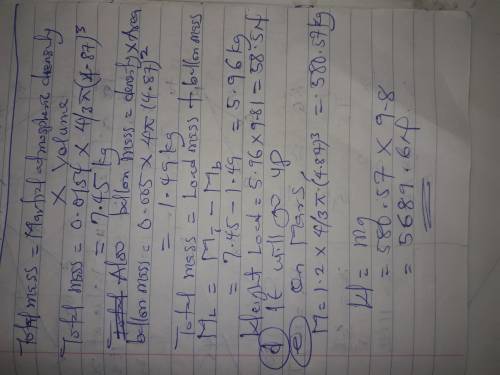
Physics, 21.04.2020 04:40 alex12everett
It has been proposed that we could explore Mars using inflated balloons to hover just above the surface. The buoyancy of the atmosphere would keep the balloon aloft. The density of the Martian atmosphere is 0.0154kgm30.0154kgm3(although this varies with temperature). Suppose we construct these balloons of a thin but tough plastic having a density such that each square meter has a mass of 5.00 g. We inflate them with a very light gas whose mass we can ignore.
(a) What should be the radius and mass of these balloons so they just hover above the surface of Mars?
(b) If we released one of the balloons from part (a) on earth, where the atmospheric density is 1.20kgm31.20kgm 3, what would be its initial acceleration assuming it was the same size as on Mars? Would it go up or down?
(c) If on Mars these balloons have five times the radius found in part (a), how heavy an instrument package could they carry?
(d) Would it go up or down?
(e) If on Mars these balloons have five times the radius found in part A, how heavy an instrument package could they carry?

Answers: 3


Another question on Physics

Physics, 21.06.2019 19:00
Modify the equation fδt=δ (mv) to find the force of friction.
Answers: 2

Physics, 22.06.2019 09:00
Yvette hangs a 2.4kg bird feeder in the middle of a rope tied between two trees. the feeder creates a tension of 480 n in each side of the the rope.
Answers: 1

Physics, 22.06.2019 11:30
If forces acting on an object are unbalanced. true or false
Answers: 1

Physics, 22.06.2019 13:10
Most short-period comets do not have randomly oriented orbits because
Answers: 2
You know the right answer?
It has been proposed that we could explore Mars using inflated balloons to hover just above the surf...
Questions

Mathematics, 16.01.2020 00:31




Mathematics, 16.01.2020 00:31

Advanced Placement (AP), 16.01.2020 00:31

Mathematics, 16.01.2020 00:31


Mathematics, 16.01.2020 00:31

History, 16.01.2020 00:31

English, 16.01.2020 00:31

Chemistry, 16.01.2020 00:31

Biology, 16.01.2020 00:31

History, 16.01.2020 00:31




Mathematics, 16.01.2020 00:31

History, 16.01.2020 00:31

Mathematics, 16.01.2020 00:31






